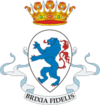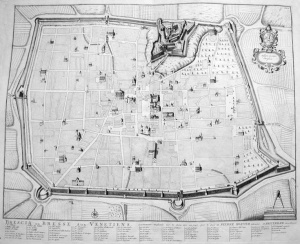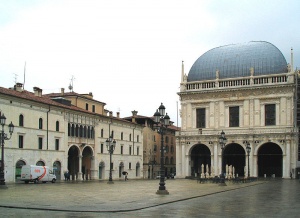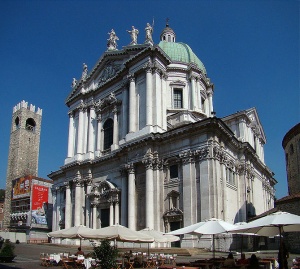Brescia
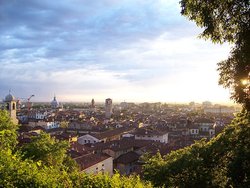
| |
| Comune di Brescia | |
|---|---|
| Region | Lombardy |
| Province | Brescia (BS) |
| Elevation m | 150 |
| Area total km2 | 90.7 |
| Population as of | 2008-11-30 |
| Population total | 190809 |
| Population density km2 | 2104 |
| Timezone | CET, UTC+1 |
| Frazioni | Fornaci, Sant'Eufemia, San Polo, Urago Mella, Sant'Anna, Mompiano |
| Telephone | 030 |
| Postal code | 25100 |
| Gentilic | Bresciani |
| Mapx | 45.5 |
| Mapy | 10.24 |
| Name | Brescia |
| Saint | Sts. Faustino and Giovita |
| Day | february 15 |
| Mayor | Adriano Paroli |
| Website | www.comune.brescia.it |
Brescia (Lombard: Brèsa) is a city in the region of Lombardy in northern Italy. It is situated at the foot of the Alps, between the Mella and the Naviglio, with a population of around 190,000. It is the second largest city in Lombardy, after the capital, Milan. Brescia is called "the Lioness of Italy" after ten days of popular uprising that took place in the city in the spring of 1849 against Austrian oppression.
The city is the administrative capital of the Province of Brescia, one of the largest in Italy, with about 1,200,000 inhabitants. The ancient city of Brixia, Brescia has been an important regional centre since pre-Roman times and a number of Roman and medieval monuments are preserved, among which is the prominent castle. The city is at the centre of the third-largest Italian industrial area, concentrating on mechanical and automotive engineering and machine tools, as well as the Beretta arms firm. Its companies are typically small or medium- sized enterprises, often with family managements. The financial sector is also a major employer, and the tourist trade benefits from the proximity of Lake Garda, Lake Iseo and the Alps.
The plan of the city is rectangular, and the streets intersect at right angles, a peculiarity handed down from Roman times, though the area enclosed by the medieval walls is larger than that of the Roman town, which occupied the eastern portion of the present one. The Piazza del Foro marks the site of the forum, and the museum on its north side is ensconced in a Corinthian temple with three cellae, by some attributed to Hercules, but more probably the Capitolium of the city, erected by Vespasian in 73 AD (if the inscription really belongs to the building), which was excavated in 1823. The museum houses a famous bronze statue of Victory, found in 1826. Scanty remains of a building on the south side of the forum, called the curia, but which may have been a basilica, and of the theatre, east of the temple, still exist.
History
Ancient era
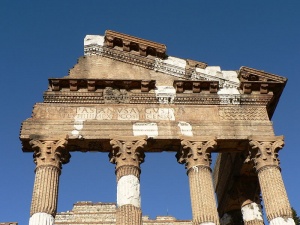
Different mythological versions of the foundation of Brescia exist: one assigns it to Hercules, while another attributes its foundation to Altilia ("the other Ilium") by a fugitive from the siege of Troy. According to a further myth, the founder was the king of the Ligures Cidnus, who had invaded the Padan Plain in the late Bronze Age. Scholars attribute the foundation to the Etruscans.
Invaded by the Gallic Cenomani, allies of the Insubres, in the 4th century BC, it became their capital. The city became Roman in 225 BC, when the Cenomani submitted to Virginia. During the Carthaginian Wars 'Brixia' was usually allied with the Romans. In 202 BC it was part of a Celtic confederation against them, but, after a secret agreement, changed side and attacked the Insubres by surprise, destroying them. Subsequently the city and the tribe entered the Roman world peacefully as faithful allies, maintaining a certain administrative freedom. In 89 BC Brixia was recognized as civitas ("city") and in 41 BC its inhabitants received Roman citizenship. Augustus founded a civil (not military) colony there in 27 BC, and he and Tiberius constructed an aqueduct to supply it. The Roman Brixia had at least three temples, an aqueduct, an amphitheater, a forum with another temple built under Vespasianus, and some baths.
When Constantine advanced against Maxentius in 312, an engagement took place at Brixia in which the enemy was forced to retreat as far as Verona. In 402 the city was ravaged by the Visigoths of Alaric I. During the invasion of the Huns under Attila, the city was again besieged and sacked in 452 while, some forty years later, it was one of the first conquests of the Gothic general Theoderic the Great in his war against Odoacer.
Middle Ages
In 568 or 569 Brescia was occupied from Byzantines by the Lombards, who made it the capital of one of their semi-independent duchies. First duke was one Alachis, who died in 573. Later dukes included the future king Rotharis and Rodoald, and Alachis II, a fervent anti-Catholic who was killed in the batte of Cornate d'Adda (688). The last king of the Lombard, Desiderius, had been also duke of Brescia. In 774 Charlemagne captured the city and ended the existence of the Lombard kingdom in northern Italy. Notingus was the first (prince-)bishop (in 844) who bore the title of Count (see Bishopric of Brescia). From 855 to 875, under Louis II the Younger Brescia become de facto, capital of Holy Roman Empire. Later the power of the bishop as imperial representative was gradually defied by the local citizens and nobles, Brescia becoming a free commune around the early 12th century. Subsequently it expanded in the nearby countryside, first at the expenses of the local landholders, and later against the neighbouring communes, notably Bergamo and Cremona. Brescia defeated the latter two times at Pontoglio, and then at the Grumore (mid-12th century) and in the battle of the Malamorte(Bad Death) (1192).
In the successive struggles between the Lombard cities and the emperors, Brescia was implicated in some of the leagues and in all of the uprisings against them. In the Battle of Legnano the contingent from Brescia was the second in size after that of Milan. The Peace of Constance (1183) that ended the war with Frederick Barbarossa confirmed officially the free status of the commune. In 1201 the podestà Rambertino Buvalelli made peace and established a league with Cremona, Bergamo, and Mantua. Memorable is also the siege laid to Brescia by the emperor Frederick II in 1238 on account of the part taken by this city in the battle of Cortenova (27 November, 1237). Brescia came through this assault victorious. After the fall of the Hohenstaufen, republican institutions declined at Brescia as in the other free cities and the leadership was contested between powerful families, chief among them the Maggi and the Brusati, the latter of the (pro-imperial, anti-papal) Ghibelline party. In 1258 it fell into the hands of Ezzelino da Romano.
In 1311 Emperor Henry VII laid siege to Brescia for six months, losing three-fourths of his army. Later the Scaliger of Verona, aided by the exiled Ghibellines, sought to place Brescia under subjection. The citizens of Brescia then recoursed to John of Luxemburg, but Mastino II della Scala expelled the governor appointed by him. His mastery was soon contested by the Visconti of Milan, but not even their rule was undisputed, as Pandolfo III Malatesta in 1406 took possession of the city, but in 1416 bartered it to Filippo Maria Visconti, who in 1426 sold it to the Venetians. The Milanese nobles forced Filippo to resume hostilities against the Venetians, and thus to attempt the recovery of this city, but he was defeated in the battle of Maclodio (1427), near Brescia. In 1439 Brescia was once more besieged by Francesco Sforza, captain of the Venetians, who defeated Niccolò Piccinino, Filippo's condottiero. Thenceforward Brescia acknowledged the authority of Venice, with the exception of the years between 1512 and 1520, when it was occupied by the French armies under Gaston of Foix, Duke of Nemours. Early in the 16th century it was one of the wealthiest cities of Lombardy, but has never recovered from its sack by the French. It subsequently shared the fortunes of the Venetian republic until 1796, when it came under Austrian dominion.
Modern era
After the end of the Napoleonic era, Brescia was annexed to the Austrian puppet state called Kingdom of Lombardy-Venetia. Brescia revolted in 1848. It distinguished again for the revolt called the Ten Days of Brescia (march 1849), for which the poet Giosuè Carducci called it "Leonessa d'Italia" ("Italian Lioness"), being the only Lombard town to rally to Charles Albert in the latter year; but was taken after ten days' obstinate street fighting by the Austrians under Haynau.
In 1769 the city was devastated when the Church of San Nazaro was struck by lightning. The resulting fire ignited 90,000 kg of gunpowder being stored there, causing a massive explosion which destroyed one sixth of the city and killed 3,000 people.
Brescia was annexed to Italy in 1859.
The city was awarded a Gold Medal for its resistance against Fascism, in World War II.
On May 28, 1974, it was the seat of the bloody Piazza della Loggia bombing.
Main sights
- Piazza della Loggia, a noteworthy example of Renaissance piazza, with the eponymous loggia (the current Town Hall) built in 1492 by the architect Filippino de' Grassi. On May 28 1974 the square was the location of a terrorist bombing.
- Duomo Vecchio ("Old Cathedral"), also known as La Rotonda. It is an exteriorly rusticated Romanesque church, striking for its circular shape. The main structure was built in the 11th century on the ruins of an earlier basilica. Near the entrance is the pink Veronese marble sarcophagus of Berardo Maggi, while in the presbitery is the entrance to the crypt of San Filastrio. The structure houses paintings of the Assumption, the Evangelists Luke and Mark, and Feast of the Paschal Lamb , and Eli and the Angel by Alessandro Bonvicino (known as il Moretto); two canvasses by Girolamo Romanino, and other paintings by Palma il Giovane, Francesco Maffei, Bonvicino, and others.
- Duomo Nuovo ("New Cathedral"): Construction on the new cathedral began in 1604 and continued till 1825. While initially a contract was awarded to Palladio, economic shortfalls awarded the project, still completed in a Palladian style, to the young Brescian architect Giovanni Battista Lantana, with decorative projects were directed mainly by Pietro Maria Bagnadore. The facade is mainly owed to the designs Giovanni Battista and Antonio Marchetti, while the cupola was designed by Luigi Cagnola. Interior frescoes including the Marriage, Visitation, and Birth of the Virgin, as well as the Sacrifice of Isaac, were frescoed by Bonvicino. The main attractions is the Arch of Sts. Apollonius and Filastrius (1510)
- The Broletto, formerly the Province Hall. It is a massive building of the 12th and 13th centuries with a lofty tower.
- In Piazza del Foro is the most important array of Roman remains in Lombardy. These include the Capitoline Temple, built by Vespasianus in 73 AD.
- The monastery of San Salvatore (or Santa Giulia), dating from the Lombard age but later renovated several times. It is one of the best example of High Middle Ages architecture in northern Italy.
- Santa Maria dei Miracoli (1488-1523), with a fine façade by Giovanni Antonio Amadeo, decorated with bas-reliefs and a Renaissance peristilium.
- The Romanesque-Gothic church of St. Francis, with a Gothic façade and cloisters.
- The castle, at the north-east angle of the town, commands a fine view.
- Church of San Nazario e Celso, with the Averoldi Polyptych by Titian.
- Church of San Clemente, with numerous painting by Alessandro Bonvicino (generally known as Moretto).
- Church of San Giovanni, with a refectory partly painted by the Moretto and partly by Girolamo Romanino.
- The Pinacoteca Tosio Martinengo, the local art gallery hosts works of the painters of the classical Brescian school, Romanino, Bonvicino, and Bonvicino's pupil, Giovanni Battista Moroni.
- Biblioteca Queriniana, containing rare early manuscripts, including a 14th-century manuscript of Dante, and some rare incunabula.
The city has no fewer than seventy-two public fountains. The stone quarries of Mazzano, 20 km east of Brescia, supplied marble for the Monument to Vittorio Emanuele II in Rome.
Sports
Brescia is the start and the arrival of the historical car race Mille Miglia that takes place every year in May and also the now defunct Coppa Florio, one of the first ever sport motor races. It is also the home of Brescia Calcio football club and Rugby Leonessa 1928.
Famous citizens
- Veronica Gambara (1485 - 1550) poet and stateswoman.
- Giovanni Paoli (Juan Pablos) Brought the printing press to the new world in Mexico City under the viceroyalty of Antonio de Mendoza from Spain in 1935.
- Rothari or Rotari, King of Lombards
- Rodoald or Rodoaldo, King of Lombards
- Desiderius, King of Lombards
- Louis II, Holy Roman Emperor, Frankish Emperor and King of Italy
- Arnold of Brescia, a monk who lived in the 12th century
- Albertanus of Brescia, 13th C. Latin author.
- Saint Angela Merici, who founded the Order of Ursulines in Brescia in 1535
- Niccolo Fontana Tartaglia, mathematician, in the 16th century
- Bartolomeo Beretta, gunsmith and founder of the Beretta arms firm
- Giulio Alenio, (Brescia 1582-Yanping 1649) Jesuit missionary called "Confucius from the West"
- Benedetto Castelli, mathematician and expert in hydraulics, in the early 17th century
- Pietro Gnocchi, eccentric polymath and composer, 1689–1775
- Camillo Golgi experimental pathologist, b. 1843, d. 1926, received the Nobel Prize in Physiology or Medicine in 1906 for his studies of the structure of the nervous system
- Giuseppe Zanardelli, b. 1826, d. 1903 - Jurisconsult, politician, Prime minister of the Kingdom of Italy (February 15, 1901 – November 3, 1903)
- Arturo Benedetti Michelangeli, a pianist of 20th century
- Pope Paul VI
- Gasparo da Salò, b. 1540, d. 1609 - pioneer of violin making
- L'Aura, b.1984 - singer-songwriter
- Andrea Pirlo, football player
- Manuel Belleri, football player
- Giacomo Agostini Born 1942. World famous Grand Prix motorcycle racers 1964 - 1977.
- Marco Cassetti, a football player for Serie A team AS Roma.
- Marcus Nonius Macrinus, Roman General and consul to Emperor Marcus Aurelius
See also
